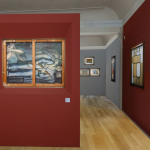Hamburger Bahnhof
Berlin, Germany
Joseph Beuys
This time in our series of reviews we visit Joseph Beuys’ digitized exhibition through a three-dimensional model created by Walter’s Cube. This technological innovation lets the visitors enjoy the artworks in a proportionally scaled digital twin in real time, where walking around and interacting grows into an immersive experience thanks to the Online Viewing Room.
In 1974, Joseph Beuys arrived in America without actually setting foot on the ground as the beginning of the three day long performance called I Like America and America Likes Me. At Immigration, as everybody else, he was asked about his profession: “social sculptor”, he answered, still covering his eyes with his hands in order to not see anything from America. Apart from the coyote waiting for him at the René Block Gallery.
This statement could be interpreted as him defining himself as a sculptor who handles societal problems in his art, but it’s rather about him wanting to sculpt society through his art, since he did not separate art from politics.
He considered changing the existing order to be his mission. He said “After I am dead I would like people to say: ‘Beuys understood the historical situation. He altered the course of events.’ I hope in the right direction.”

Available on the Online Viewing Room
This did not make his art more logical or rational. On the contrary, it encouraged the viewers to be more esoteric, as he was highly influenced by Rudolf Steiner’s philosophy that was based on the belief of spiritual uplift and societal transformation.
So Beuys became the shaman of artistic psychoanalysis, the alchemist of symbolic metamorphosis of inferior materials, an adamant environmentalist, and a rather aggressive activist (he literally fought a boxing match for democracy after a 100-day debate). All wrapped up in the persona of a storyteller. This is the information we need to make sense of the sculpture titled Unschlitt/Tallow, which is a 10-metre-long wedge randomly cut into six pieces, made in a cast filled with tallow.

Available on the Online Viewing Room
The sculpture was originally made in 1977 for the Landesmuseum in Münster, after a pedestrian underpass on Schlossplatz, but has been on permanent loan to the Hamburger Bahnhof in Berlin for years now. It is a commentary on both the spatial effects of sculptures, and on empty public spaces being wasted to the point they start to feel hollow. The real catch is in the nature of tallow: on higher temperatures, it melts.
That’s why the blocks are constantly monitored, as body heat could deform them. There is a double meaning to it, because on one hand it demonstrates the change one person can make. On the other hand, it carries the promise that the melting grease will fuse into the viewer.
As Beuys said, “The work of art enters into the person and the person internalizes the work of art as well, it has to be possible that these two completely sink into each other … Art enters into the person and the person enters into the work of art, no?”

Available on the Online Viewing Room
This magical transfiguration brings us back to him being a shaman, or as some put it, a charlatan: Beuys is so preoccupied with symbolism and myths, he doesn’t care about staying true to the facts, as a good story has immense power.
This is why he came up with the tale of being rescued by Tatars after his plane crashed in the Crimea during World War II. According to him, the tribesmen saved his life by covering him with tallow and felt, keeping him from freezing to death, so these materials became symbols of healing in his art, as changing society for the better is the direct equivalent of saving and healing.
But this never actually happened: Beuys was telling a lie, or, if you prefer, he was creating a new myth, partly to reclaim the right of doing so from the Nazis, partly to show the world needs creative narratives more than dry logic.














